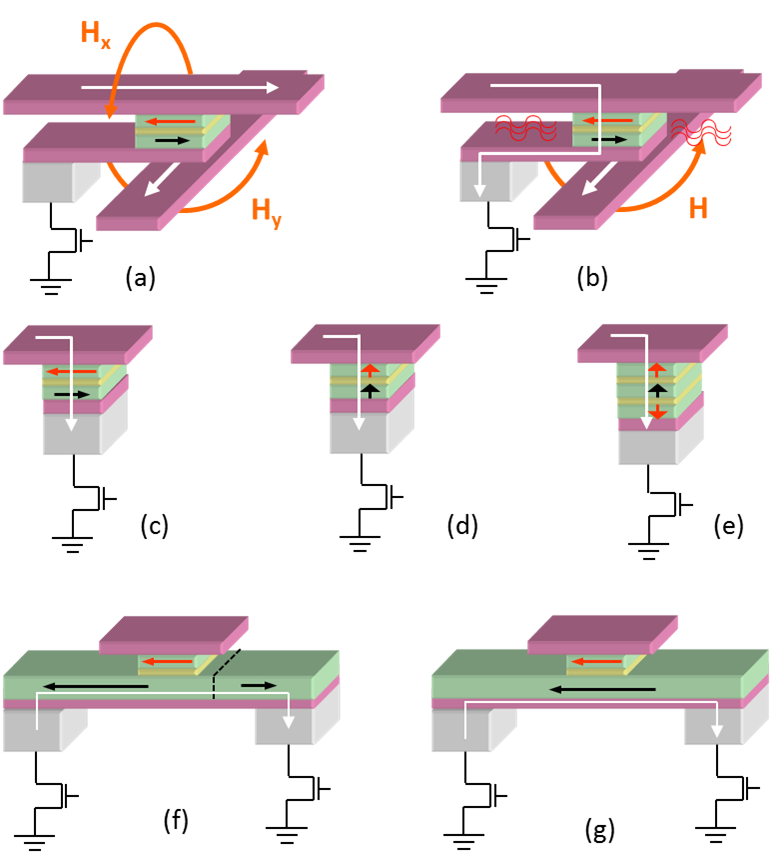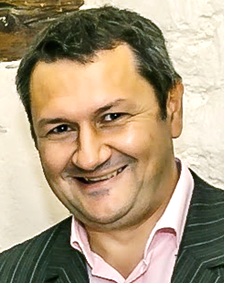Thematic overview
Magnetic Random Access Memories (MRAM) is a non-volatile memory technology, where information is stored by the magnetization direction of magnetic electrodes, very similar to computer hard-disk drives. The goal for MRAM memory is to simultaneously achieve high-speed read/write times, high density and unlimited cycling compared to other existing and emerging technologies.
Our group is developing advanced MRAM cell concepts patented at Spintec. The concepts are based on the use of temperature to reduce power consumption and increase the stability of the stored information. These ideas go beyond the conventional MRAM approach. The naturally occurring temperature increase during the write step is not lost, but is instead used to achieve the seemingly opposing goal of lowering the power consumption and increasing the thermal stability in the operating temperature range. Our group fosters young and experienced researchers developing/applying their expertise in the field of MRAM.

Questions to be addressed
Our main research axis is to use the naturally occurring temperature increase during the write step, when a current flows through the magnetic tunnel junction. The heating is used to go above a temperature threshold, making it possible to write the storage layer magnetization. This principle has been applied to in-plane magnetization cells using a storage layer pinned by an anti-ferromagnet and recently to perpendicular anisotropy cells. Our group’s goal is to demonstrate the proof-of-concept and then improve MRAM cell properties.
Our work involves the development of magnetic material systems, nano-fabrication (20-200nm cells), characterization of devices (magnetic & electrical) and simulation of the device behavior. Our activity in these vast fields is as follows;: On materials research, we are developing magnetic tunnel junctions with in-plane and perpendicular magnetic anisotropy. New electrode stacks having the material properties required by each specific concept need to be integrated in magnetic tunnel junctions, while achieving high levels of TMR signal. For the characterization of each concept we determine the write window parameters in terms of magnetic field, power consumption and magnetization reversal dynamics. Macrospin and micromagnetic simulation provide a better physical understanding of the system properties and the possibilities for optimization.
Projects
ANR EXCALYB – Perpendicular Anisotropy Materials for High-Density Non-volatile Magnetic Memory Cells
Crocus R&D – Thermally assisted MRAM
Samsung SGMI
Partners
Crocus Technology
Institut Néel
SP2M/NM
SAMSUNG
Applied Materials
SINGULUS
Recent news
- Sub-10nm thermally stable Perpendicular Shape Anisotropy magnetic memory [August 24th, 2018]
A new concept of thermally stable and electrically switchable Spin Transfer Torque Magnetic Random Access Memory (STT-MRAM) scalable to diameter down to 4nm was proposed and demonstrated. By dramatically increasing the thickness of the storage ... - Editor – Topical issue in MRS bulletin: Advanced memory—Materials for a new era of information technology [April 10th, 2018]
Bernard Dieny (from Spintec) and Cheol Seong Hwang are Guest Editors for a topical issue of the MRS Bulletin in May 2018, dedicated to Advanced memory—Materials for a new era of information technology. View online: DOI: ... - Electronique – Ruée sur les mémoires magnétiques (Industrie et Technologies, Mar 2018) [April 04th, 2018]
L’alliance de la microélectronique et du magnétisme, ou spintronique, s’avère prometteuse. Les géants du secteur s’intéressent notamment aux mémoires magnétiques. Industrie et Technologies 1007, 1st March 2018 - Sub-10nm thermally stable Perpendicular Shape Anisotropy STT-MRAM realized at SPINTEC [March 08th, 2018]
A team at SPINTEC in Grenoble has demonstrated thermally stable and electrically switchable Spin Transfer Torque MRAM (STT-MRAM) of diameter down to 4nm. Among the various technologies of non-volatile memories, STT-MRAM gathers a unique combination ... - Seminar : Magnetisation manipulation with light and electrons femto-second pulses [February 23rd, 2018]
On March 29, We have the pleasure to welcome Stéphane MANGIN from Institut Jean Lamour, Université de Lorraine. He comes at Grenoble for the PHD defense of Jyotirmoy Chatterjee at 14H. He kindly offered to take ...

SOUSA Ricardo
ricardo.sousa@cea.fr

BALTZ Vincent
vincent.baltz@cea.fr

PREJBEANU Lucian
lucian.prejbeanu@cea.fr

DIENY Bernard
bernard.dieny@cea.fr





